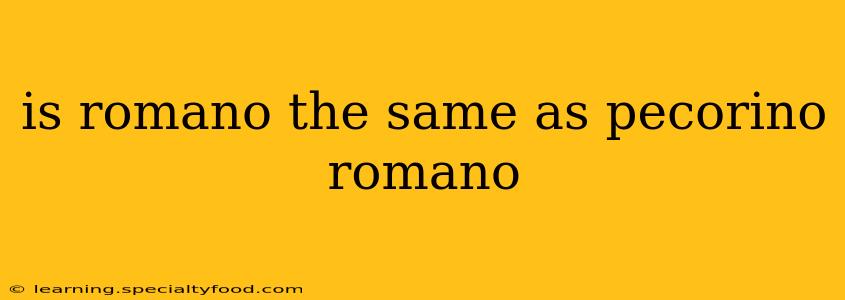Is Romano the Same as Pecorino Romano? Understanding the Cheese Connection
The short answer is: no, "Romano" and "Pecorino Romano" are not exactly the same, though they are closely related and often confused. The longer answer requires understanding the nuances of cheesemaking and regional designations.
Let's break down the differences:
What is Pecorino Romano?
Pecorino Romano is a hard, salty, sheep's milk cheese originating from specific regions of Italy: Sardinia, Lazio and Tuscany. It's protected by a PDO (Protected Designation of Origin) designation, meaning only cheese made according to strict regulations within those regions can legally be called Pecorino Romano. This includes the type of milk used (exclusively sheep's milk), the production methods, and the aging process (at least five months). The distinct, sharp, and slightly granular texture is a hallmark of authentic Pecorino Romano.
What is Romano Cheese?
"Romano" is a broader term used to describe a family of hard, salty cheeses that share similarities in texture and taste to Pecorino Romano. However, unlike Pecorino Romano, "Romano" doesn't have a specific legal protection. This means that various types of cheeses made from different milks (cow's milk, goat's milk, or a blend) can be labeled as "Romano" as long as they possess a similar flavor profile and texture. These cheeses might be produced in Italy or elsewhere, and their quality can vary significantly.
What are the Key Differences?
Here's a table summarizing the core differences:
| Feature | Pecorino Romano | Romano |
|---|---|---|
| Milk Type | 100% Sheep's Milk | Cow's milk, goat's milk, or blends |
| Origin | Sardinia, Lazio, and Tuscany (Italy) | Varies, often Italy but not limited |
| Legal Protection | PDO (Protected Designation of Origin) | None |
| Taste | Sharp, salty, slightly granular | Similar but can vary widely |
| Texture | Hard, granular | Similar, but can vary depending on milk and aging |
How Can I Tell the Difference?
The most reliable way to ensure you're buying Pecorino Romano is to look for the PDO seal. This signifies that the cheese adheres to strict regulations and comes from the designated regions. If the label simply says "Romano," it doesn't necessarily guarantee the same quality, origin, or milk type as Pecorino Romano.
Are there other types of Romano cheeses?
Yes, several types of cheeses may be labeled as "Romano". American Romano, for example, is a popular cheese in the USA, but the taste and ingredients vary considerably from the Italian versions.
In summary, while both share a similar sharp, salty character and texture, Pecorino Romano is a specific type of cheese with strict origin and production regulations, while "Romano" is a more general term encompassing a wider range of cheeses.
Understanding these differences helps consumers make informed choices based on their preferences and expectations. If you're seeking the authentic, protected Italian sheep's milk cheese, make sure to look for the "Pecorino Romano" label and PDO seal.
